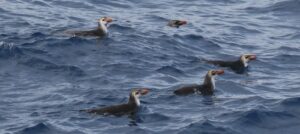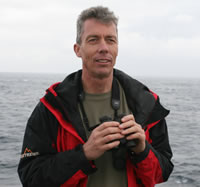By Peter Ryan, onboard scientist, expert in general ornithology, seabird-fishery interactions, evolutionary ecology, marine debris, solid waste management, biology of oceanic islands.
Leg 2, Day 4.
Today dawned calm and crisp; having crossed the Antarctic Polar Front in the night, the water was about 3°C and the air little warmer. The calm conditions made for easy sightings of animals on the water, as well as drifting debris, and those prepared to wait on deck were rewarded with at least five pods of Hourglass Dolphins (about 40 animals all told, often accompanied by large flocks of shearwaters). Later in the day, whales started to put in an appearance, with a couple of groups of Fin Whales, and two unidentified ?beaked whales. The ship stopped on station just before 17h00, shortly after passing a group of Fin Whales, and after about an hour a curious individual visited the ship, drawing crowds of appreciative onlookers to the Monkey Island and bow. Bird of the day was a rescue of Royal Penguin – having skipped Macquarie Island, this species seemed destined to elude us, but two groups were encountered, feeding in the same cold waters as their close relative, the Macaroni Penguin. Dip of the day for the birders was a single Campbell Albatross, photographed by Josh as it circled the ship while we sampled microplastics…
| Short-tailed Shearwater | 530 | Black-bellied Storm Petrel | 12 |
| White-headed Petrel | 11 | Antarctic Prion | 11 |
| Mottled Petrel | 10 | Royal Penguin | 6 |
| Sooty Shearwater | 5 | Salvin’s? Prion | 2 |
| Rockhopper Penguin | 1 | Wandering Albatross | 1 |
| Southern Royal Albatross | 1 | Campbell Albatross | 1 |
| Grey-headed Albatross | 1 | Diving petrel sp. | 1 |
| Chinstrap Penguin | + |
Two litter items were seen in general transects, and Guiseppe recorded a further piece of plastic in his dedicated litter transects, making this the dirtiest day south of 45°S. Bull Kelps also were much more abundant than yesterday, not knowing they are supposed to remain north of the Antarctic Polar Front…

